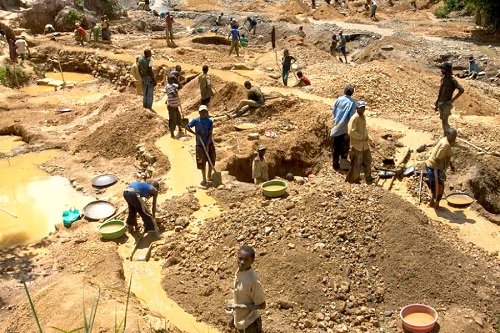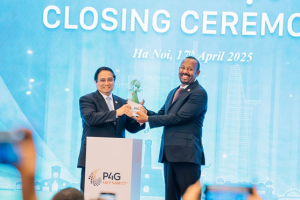
Ethiopia is gradually turning its face towards harnessing its mining resources as a pivotal driver of economic growth and development. The country is estimated to be unaware of approximately 70% of its mineral wealth, primarily due to inadequate exploration and research methodologies, as well as a lack of technological support.
As a result, Ethiopia has only managed to identify between 30% and 40% of its total mineral resources. This underutilization of mineral assets not only hinders economic growth but also prevents the country from fully leveraging its resources for sustainable development.
The mining sector has a potential to become a backbone of Ethiopia’s economy, yet several factors hinder its full potential. Key challenges include insufficient infrastructure, outdated technology and equipment, the absence of well-trained personnel, and a lack of comprehensive studies on mineral deposits. These issues severely impede the ability to locate and exploit mineral resources effectively.
On the other hand, some experts argue that there are no comprehensive studies examining how mining resource exploration impacts not only the mining sector itself but also other critical pillars of the country’s economy, such as agriculture, manufacturing, and services, thereby limiting our understanding of its broader economic effects.
Despite these challenges, the Ethiopian government has been striving to address these issues and enhance the development of the mining sector over the past five years. The Geological Institute of Ethiopia is taking significant strides to bolster investment in the nation’s mineral sector by collecting, organizing, and disseminating comprehensive data on various minerals. This initiative aims to attract both local and foreign investors interested in tapping into Ethiopia’s rich geological resources.
Recently, Ijara Tesfaye, the Director General of the Geological Institute, emphasized the importance of accessible and well-organized information, stating, “It is crucial to not only generate information but to present it in a timely manner that meets the needs of current investors.” The institute has undertaken extensive research across the country, leveraging geological maps to ensure comprehensive coverage of all regions, he said.
He mentioned that since its establishment, the data center has accumulated a wealth of information over 56 years, with substantial contributions made up to the 2022/23 fiscal year. This year alone, the institute plans to expand its outreach, offering thousands of data sets to stakeholders eager to explore investment opportunities in Ethiopia’s mining sector.
According to Ijara, the data center houses approximately 18,000 entries, covering a variety of information related to hydrology, engineering, physics, and other aspects of geology. This collection consists of both soft and hard copies, ensuring that data is preserved and accessible in multiple formats.
Notably, the center has compiled specific datasets on key minerals, including 267 entries related to gold and around 100 focused on iron. “Our efforts have led to a well-organized repository of information on all significant minerals, including chromite, copper, coal, nickel, and lithium,” Ijara highlighted. Additionally, the institute has conducted extensive research on geothermal energy and other geological studies, further enriching the data available for potential investors.
The institute serves a broader audience beyond just investors. Information is made available to various stakeholders, including research institutions, geology students from universities, and international researchers looking to study Ethiopia’s geology. “We aim to support any type of investor engaged in the mining sector, as well as academic and research bodies in the field,” he noted.
To facilitate access to this valuable information, the Geological Institute has implemented a dual-access system. Interested parties can either purchase data or access specific information for free, ensuring that a wide range of users can benefit from the institute’s extensive research. This move aligns with Ethiopia’s broader economic strategy to enhance the mining sector, which has the potential to significantly contribute to the country’s GDP. With increased interest from investors and a wealth of geological data at their fingertips, the future of Ethiopia’s mineral industry looks promising.
However, challenges remain on the sector. A week ago, Elias Kasahun, a mining lecturer at Addis Ababa University of Science and Technology, pointed out that Ethiopia’s mineral resources are scattered across the country. This geographical dispersion complicates further investigations and limits the effectiveness of exploration efforts.
He noted that ongoing conflicts in regions rich in minerals, such as Tigray, Wellega, and Guji, exacerbate these challenges. These areas could potentially yield substantial mineral resources, but prevailing unrest disrupts mining activities and deters investment.
Elias also highlighted the issue of illegal mining practices, which pose a serious threat to the sector’s overall health. In regions like Benishangul and Gambella, where numerous gold deposits exist, illegal operations bypass regulatory frameworks, harming legitimate miners and resulting in subpar mineral products. The lack of regulation and oversight diminishes the quality of resources extracted and poses environmental risks, he said.
Ethiopia’s special licensing of artisanal miners, while culturally significant, impedes the sustainable and efficient use of its mineral resources. Elias argues that this approach needs reassessment to enhance resource management and maximize potential economic benefits.
He further stated that Ethiopia has yet to utilize even 3% of its mineral wealth, emphasizing that identifying locations with mineral deposits is a monumental task, complicating efforts for full utilization.
In recent years, the Ethiopian government has made concerted efforts to harness these resources, aiming to diversify its economy and reduce reliance on agriculture. This strategic shift promises to bolster national revenue, create jobs, and enhance infrastructure. As Ethiopia seeks to position itself as a key player in the global mining landscape, the full utilization of its mineral wealth becomes essential for sustainable development and the improvement of living standards for its population.
Ethiopia’s mining sector has undertaken a major reform program in recent years. The reforms are designed to make investing in Ethiopia easier than ever, encourage exploration and mining, and unlock the sector’s full potential and value.
The months before last, Ethiopia has implemented macroeconomic policy reforms aimed at addressing these challenges and ensuring sustainable development. Some scholars suggest that the newly implemented monetary policy is designed to facilitate better utilization of mineral resources and combat illegality in the sector. Some experts recommend increased government attention and detailed studies to revitalize the mining industry.
According to the Minister of Mining, data shows that the Ethiopian government has prioritized the mining sector over the past five years, recognizing it as one of the five pillars of the economy and aiming to harness its full potential.
The minister’s office has indicated that a series of expos designed to facilitate connections among mineral producers, exporters, users, and technology suppliers. These events provide a platform for participants to showcase their products and services, fostering valuable market linkages. Through encouraging collaboration and innovation, the expos aim to enhance the industry’s growth and competitiveness in the global market.
Furthermore, while Ethiopia faces significant challenges in fully utilizing its mineral wealth, there are promising initiatives underway. The government’s efforts to improve the accessibility and organization of geological data, combined with a commitment to sustainable practices, could pave the way for a more robust mining sector.
By addressing infrastructure deficits, enhancing technological capabilities, and promoting responsible mining practices, Ethiopia has the opportunity to transform its mining industry into a key driver of economic growth and sustainable development.
BY FIKADU BELAY
THE ETHIOPIAN HERALD WEDNESDAY 27 NOVEMBER 2024





